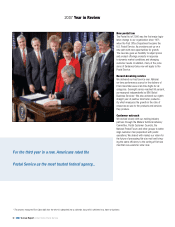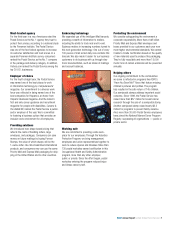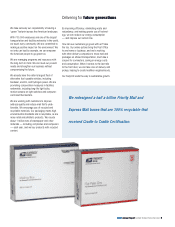US Postal Service 2007 Annual Report Download - page 16
Download and view the complete annual report
Please find page 16 of the 2007 US Postal Service annual report below. You can navigate through the pages in the report by either clicking on the pages listed below, or by using the keyword search tool below to find specific information within the annual report.16 | 2007 Annual Report United States Postal Service
Financial Section Part I
We are allowed by P.L.109-435 to file one last rate case under the current
rules, to be filed not later than December 19, 2007.
On November 15, 2007, our Governors announced that future prices will be
adjusted using regulations issued by the PRC for any future rate changes.
The PRC now has its own Office of Inspector General (OIG). The Postal
Service will continue to be required to provide the funding for our OIG, the
PRC, and the PRC’s OIG.
Additionally, P.L.109-435 requires us, beginning in 2008, to file with the
PRC a number of financial reports not previously required. These include
quarterly reports containing information required by the SEC to be filed on
Form 10-Q within 40 days after the end of each fiscal quarter, an annual
report containing information required by the SEC on Form 10-K within
60 days after the end of each fiscal year, and current reports containing
information required by the SEC on Form 8-K within the prescribed time
frame. Further, P.L.109-435 requires the Postal Service to comply with the
rules prescribed by the SEC implementing Section 404 of the Sarbanes-
Oxley Act of 2002, which pertain to reporting on the effectiveness of our
financial internal controls. The requirement to comply with the requirements
of Section 404 is effective beginning with the 2010 annual report.
Since the law’s enactment, we have been working to ensure that we
are ready to meet its requirements. Our goal is to work with the mailing
community, the PRC, and our unions and management associations to
make the transition as smooth as possible for all stakeholders. To achieve
this goal we have:
sought additional input through a
■Federal Register notice.
worked with mailers on developing modern service standards and
■
performance measurement systems.
received input on service standards from a number of other
■
stakeholders.
met with the PRC and provided extensive comments to help them
■
develop the new rules for the mailing services and shipping services
rate-setting process to ensure a smooth transition for everyone involved.
continued to work internally to prepare our systems to be ready to meet
■
the new reporting requirements both for price-setting and regulatory
reporting.
Strategy
The Strategic Transformation Plan provides focus and direction for all
Postal Service business and operating activities. It defines our vision and
establishes strategies for revenue, service, efficiency, customer-focused
culture, and sustainability.
The strategic transformation process is dynamic and adaptable. The
Plan is substantially revised every three years, and is updated annually to
accommodate ongoing changes in our business environment. This annual
planning process incorporates an ongoing assessment of performance,
refinement of strategic goals, and prioritization of programs and budgets to
optimize results. Strategic targets and specific functional objectives are then
deployed throughout the Postal Service.
Clearly, the most significant event to occur this year was the enactment
of the Postal Accountability and Enhancement Act. Although the law did
not change our fundamental mission, it did change many aspects of how
we will manage our business. Many of these changes will be reflected in
a revision to the Strategic Transformation Plan, which will be published in
December 2007.
Segments
We operate in one segment throughout the United States, its possessions,
territories and internationally.
Services
The Postal Service is the centerpiece of the U.S. mailing industry. We
provide a wide variety of services to meet almost any mailing need. Some of
our major services are
FIRST-CLASS MAIL — Includes postcards, letters, or any other
advertisement or merchandise up to 13 ounces. This service (or Express
Mail or Priority Mail) is required for personal correspondence, handwritten
or typewritten letters and bills or statements of account.
PRIORITY MAIL — This 1–3 day nonguaranteed delivery service is
typically used to send documents, gifts and merchandise.
EXPRESS MAIL — This overnight money-back guaranteed service
includes tracking, proof of delivery, and insurance up to $100. Delivery
is offered to most destinations and is available 365 days a year with no
extra charge for weekend and holiday delivery.
PERIODICALS — Offered for newspaper, magazine, and newsletter
distribution and requires prior authorization by the Postal Service.
STANDARD MAIL — Is offered for any item, including advertisements
and merchandise weighing less than 16 ounces, that is not required to
be sent using First-Class Mail. Standard Mail is typically used for bulk
advertising to multiple delivery addresses. Content restrictions apply for
authorized nonprofit mailers.
PACKAGE SERVICES — Are offered for any merchandise or printed
matter weighing up to 70 pounds. These services include Parcel Post,
Bound Printed Matter, Library Mail, and Media Mail.
SPECIAL SERVICES — Offer a variety of enhancements that add value
to mail services by providing added security, proof of delivery, or loss
recovery. These services include: Certified Mail, Registered Mail, Delivery
Confirmation, Signature Confirmation, and insurance up to $1,000.
MONEY ORDERS — Are offered as a safe, convenient, and economical
alternative to sending cash through the mail. They can be purchased
at any Post Office or from any rural route carrier. Postal money orders
are available for any amount up to $1,000 and are restricted to a daily
purchase limit of $10,000 per customer. Money orders can be cashed at
any Post Office or can be deposited or negotiated at financial institutions.
Money orders are replaced if damaged, lost, or stolen.
Details of our revenue by mail categories are found in the Operating
Statistics Section on page 54 of this report.
























